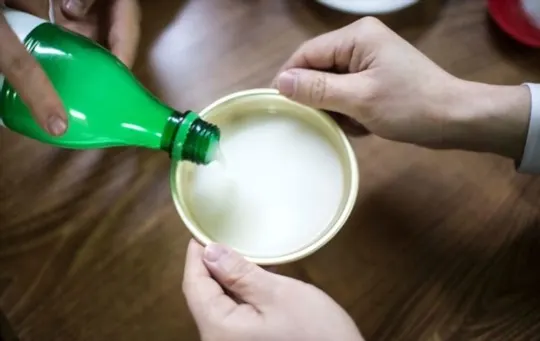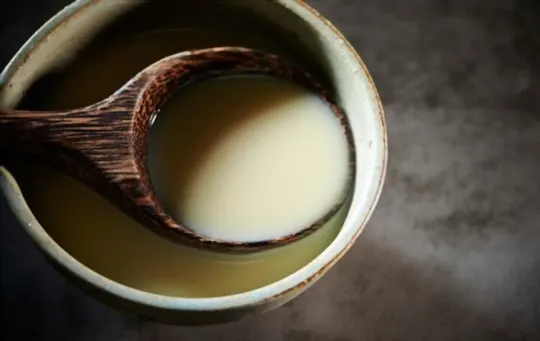Are you curious about makgeolli?
Have you heard or read about it, but are unsure of what it tastes like? Look no further!
In this comprehensive guide we will take a deep dive into the mysterious and complex taste of makgeolli.
From its naturally sweet flavor to its unique fermentation process and diverse ingredients, here’s everything you need to know about the traditional alcoholic beverage from Korea.
You’ll be able to discover why this drink continues to fill glasses at dinner tables nationwide with ease after reading through all the exciting facts that make up makgeolli’s tantalizing flavor profile.
What is Makgeolli?

Makgeolli is a traditional Korean alcoholic beverage that has been consumed for centuries.
It is a milky-white, lightly carbonated rice wine made with a mixture of boiled rice, water, and nuruk, a fermentation starter culture made from dried grains and other ingredients.
The taste and alcohol content may vary depending on the region it is made in.
Makgeolli has a rich history in Korean culture and has been enjoyed by farmers, laborers, and intellectuals alike.
It was often used as a celebratory drink during festivals or after hard work in the fields.
In recent years, it has gained popularity for its unique taste and health benefits.
To make makgeolli, rice is cooked until soft and mixed with water to create a porridge-like consistency.
Nuruk is then added to the mixture to begin the fermentation process.
After several days of fermentation, the liquid is strained to remove any solids and bottled for consumption.
In summary, makgeolli is a traditional Korean rice wine that has been enjoyed for centuries.
It has a unique taste profile characterized by a creamy texture and slightly sweet and sour flavor.
Its popularity continues to grow both domestically in Korea as well as internationally due to its health benefits and flavorful taste.
What Does Makgeolli Taste Like?

Makgeolli is a traditional Korean rice wine that has gained popularity in recent times.
If you’re new to Makgeolli, you might be curious about its taste.
The main element that sets Makgeolli apart from other alcoholic beverages is its unique taste.
Makgeolli’s taste can vary, but it generally has a sweet and tangy flavor profile.
The sweetness comes from the natural sugars found in the rice used to produce the beverage, while the tanginess results from the fermentation process.
A slightly carbonated sensation also contributes to its distinct taste.
Another factor that affects the taste of Makgeolli is its alcohol content.
A higher alcohol percentage can cause a stronger and more robust flavor profile, while lower alcohol percentages tend to have a milder and smoother taste.
The serving temperature also plays a role in determining Makgeolli’s taste.
Cold Makgeolli tends to have a more refreshing, almost fruity flavor profile-like apple cider-while warmer versions are bolder and more savory with nutty undertones.
So, experiment with different temperatures based on your preference.
If you happen to pair it with appetizers such as spicy fried chicken or kimchi pancakes, it will accentuate the overall experience by balancing out the spiciness of those dishes while amplifying their flavors.
Factors that Affect the Taste of Makgeolli

The taste of makgeolli varies depending on several factors such as the ingredients used, the fermentation process, and the temperature at which it is stored.
These factors play a crucial role in determining the final taste of this traditional Korean drink.
Ingredients are one crucial factor that can influence the taste of makgeolli.
Specifically, the type and quality of rice, yeast, and water used can affect its flavor profile.
Rice with high amylopectin content produces a sweeter taste while low-amylopectin rice results in a more acidic flavor.
Similarly, using different strains of yeast can lead to variations in taste.
The fermentation process also plays a significant role in determining the taste of makgeolli.
Longer fermentation periods result in a richer and more complex flavor profile with increased acidity levels.
Conversely, shorter fermentation times may produce a lighter-bodied drink with less pronounced flavors.
Lastly, storage temperature is another variable that can influence the taste of makgeolli.
Storing it at lower temperatures tends to decrease its sourness levels while warmer storage temperatures may increase acidity levels.
With all these important factors considered, understanding how each aspect contributes to the overall flavor profile will help you discover your ideal version of this historic Korean beverage.
1 – Ingredients
Makgeolli is a traditional Korean rice wine that has grown in popularity over the years, both domestically and internationally.
The flavor profile of this alcoholic beverage is determined by various factors, including the ingredients used during its preparation process.
All these ingredients are combined in a specific ratio to achieve a balanced taste for Makgeolli.
The quality of these ingredients also determines the final product’s taste, aroma, color, and texture.
In summary, each ingredient has its own contribution to defining how your makgeolli tastes like – a unique blend put together in perfect harmony to give you an exquisite drinking experience.
2 – Fermentation Process
The fermentation process is an essential step in the making of Makgeolli.
During this phase, yeast and lactic acid bacteria break down the rice starches and convert them into alcohol and other compounds.
This process is responsible for the unique taste, aroma, and texture of Makgeolli.
The fermentation process begins with washing and steaming glutinous rice before mixing it with nuruk, water, yeast, and lactic acid bacteria.
The mixture is then left to ferment at a warm temperature of around 25-30°C for several days until it reaches an alcohol content of around 6-8%.
During this time, the enzymes in the nuruk break down the rice starches into simple sugars which are then consumed by both yeast and lactic acid bacteria.
This dual-fermentation process results in a unique blend of flavors from both alcohol and lactic acid.
The length of time for fermentation can vary depending on several factors such as temperature or the type of nuruk used.
Once fermented, it is filtered through cotton cloth to remove any residue or impurities.
The final product is a smooth, milky-white beverage that is low in alcohol content.
Makgeolli makers believe that different microorganisms present during fermentation contribute to distinct flavors in their products.
Therefore, there are many variations of Makgeolli made using different combinations of ingredients such as barley instead of rice or wild, airborne yeasts instead of commercial ones.
3 – Age
Ageing is an essential process for most of the alcoholic beverages.
Makgeolli is no exception to this rule.
As the fermentation process ends, the next step is ageing, which lasts for about a week or two.
Just like how the flavour and texture of wine and whiskey change over time, Makgeolli also evolves during its ageing process.
During ageing, Makgeolli becomes sourer and loses some of its sweetness.
This phase is crucial in developing the complexity of flavours in Makgeolli.
The sourness that develops during ageing comes from naturally occurring lactobacillus bacteria, which continue to ferment even after storing it in cold temperatures.
Makgeolli can be aged up to six months without any pasteurization or preservatives, but most commercially available ones are aged for only a week or two before being bottled.
Ageing beyond two weeks can make it taste too sour, almost vinegar-like, for many people’s taste buds.
Another effect of ageing is that it helps settle down the sedimentation that occurs naturally since Makgeolli contains rice particles suspended in water.
Thus when you buy an unaged bottle of Makgeolli from the store shelves, you’ll usually see a clear liquid on top and whitish residue at the bottom.
After ageing, this sediment sets at the bottom making it easier to pour out just the right amount without disturbing the sedimentation.
How to Serve Makgeolli?

When it comes to serving Makgeolli, it’s important to know that it’s traditionally consumed at room temperature.
This means that you can take the bottle out of the refrigerator about 30 minutes before serving to allow it to warm up a bit.
Makgeolli is typically served in small bowls or cups, and it’s common for the person pouring the drink to hold the bowl or cup with one hand while using their other hand to pour.
While some people may prefer to drink Makgeolli straight, others like to mix it with fruit or other flavorful ingredients.
For example, you might add sliced strawberries or kiwi fruit to a pitcher of Makgeolli for a refreshing and fruity twist on this traditional beverage.
Alternatively, you could try mixing in some honey or ginger for added flavor.
When serving Makgeolli, you should also be aware of its carbonation levels.
Unlike beer or soda, Makgeolli doesn’t have artificial carbonation – instead, bubbles are created naturally as part of the fermentation process.
This means that if you shake or stir the bottle too much before pouring, you could end up with a glass full of foam.
To avoid this, gently rotate the bottle before opening and pouring.
In addition to these basic tips, there are many other ways to serve and enjoy Makgeolli depending on your personal preferences and tastes.
Some people like to pair it with salty foods like kimchi or pickled vegetables, while others prefer sweeter snacks like dried fruits or nuts.
Experimenting with different combinations can be a fun way to discover new flavors and experiences.
Is Makgeolli Healthy?
Makgeolli, a traditional Korean rice wine, is often praised for its unique flavor and smooth texture.
However, one might wonder if this popular drink has any health benefits.
So, is Makgeolli healthy?
- It’s important to note that Makgeolli is made from fermented rice, water, and additional ingredients such as wheat or barley. Fermentation is known to have potential positive effects on gut health by increasing the number of beneficial bacteria in our digestive system.
- Additionally, Makgeolli does not contain preservatives or sulfites commonly found in other alcoholic beverages. This makes it a healthier option for those who are sensitive to these additives.
- Makgeolli also has a lower alcohol content compared to other alcoholic beverages. This means that drinking a moderate amount of Makgeolli may reduce the risk of alcohol-related health issues such as liver disease and high blood pressure.
- However, it’s important to remember that excessive alcohol consumption can have negative effects on your health despite the type of drink. Therefore, moderation is key when it comes to enjoying Makgeolli.
Conclusion
Makgeolli seems to be a healthy drink option as it is low in alcohol content and contains probiotics that promote digestive health.
However, one should not over-consume Makgeolli as it may lead to adverse health effects such as obesity and liver damage.
Overall, while Makgeolli can be considered a healthier option compared to other alcoholic beverages, it should still be consumed in moderation due to its potential side effects.
This Korean rice wine has a unique taste that may take some getting used to but can be an enjoyable drink when paired with certain foods or enjoyed on its own.

What Does Makgeolli Taste Like? A Comprehensive Guide
Ingredients
- Makgeolli
- Ingredients from your selected recipes
Instructions
- Select ingredients that work well together.
- Use a recipe or method that will enhance their natural taste.
- Taste and adjust the recipe as needed to achieve the desired flavor.

Carrie is a food writer and editor with more than 15 years of experience. She has worked for some of the biggest names in the food industry, including Bon Appétit, Food & Wine, and Martha Stewart Living.
As the Editor in Chief of IntroChicago.com, Carrie oversees all of the content on the site. She also manages the team of contributing writers and editors, who help to create delicious recipes, helpful tips, and informative articles that you’ll find on the site.
A native of the Chicago area, Carrie is passionate about all things food. She loves trying new restaurants and experimenting with new recipes in her kitchen. She’s also a graduate of the Culinary Institute of America, so she knows a thing or two about food!
